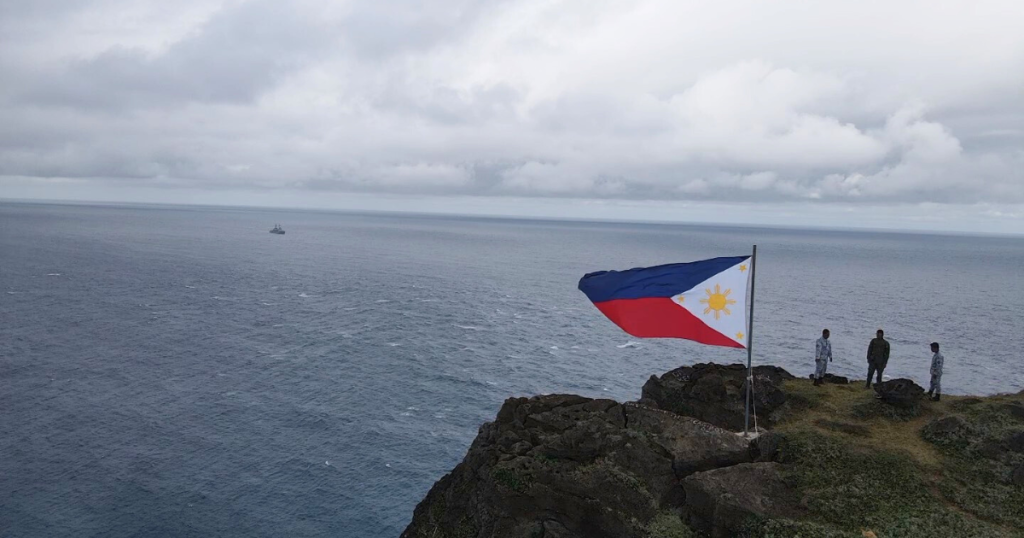Philippines adopts new defense strategy to protect maritime borders

A Philippine flag flies over a cliff in Batanes, considered a flashpoint amid the tensions on the disputed waters in the South China Sea. Photo from Philippine Navy.
By Manuel Mogato | Date 03-11-2024
MANILA — Worried about frequent intrusions from foreign vessels over its sovereign waters, the defense secretary ordered the military to tighten border security, adopting a new defense strategy to protect its national interests.
Gilberto Teodoro Jr. said the new defense strategy would focus on increasing its presence and building more structures in the border areas, like Batanes and Palawan provinces.
The new defense strategy — Comprehensive Archipelagic Defense Concept (CADC) – would boost the country’s maritime domain awareness and enhance the military’s area denial and anti-access (A2AD) capabilities.
“We are developing our capability to protect and secure our entire territory and exclusive economic zone to ensure that our people and all the generations of Filipinos to come shall freely reap and enjoy the bounties of the natural resources that are rightfully ours within our domain,” Teodoro said.
Based on the new defense strategy, Teodoro said the military would increase deployments in border areas in the north, particularly in Batanes, and in the west, including Palawan and the Kalayaan Group of Islands, where China has increased presence and activities.
More military bases would be developed and shared with allies, like the United States, particularly in Cagayan province, Palawan Island, and central Luzon region.
Other Southeast Asian states, which have conflicting claims in the South China Sea, have also increased their presence in disputed areas, upgraded military capabilities, and fortified occupied features in the Spratly.
“This would address our vulnerabilities and enhance our capability to defend our national interest through certain long-term plans, which include upgrades in our facilities and deployment of personnel,” Teodoro said.
He added the Philippines has drawn up a list of equipment to strengthen territorial defense as regional tensions grow with the intense big powers rivalry.
For instance, the government has recently approved a ten-year, P1.9 trillion third horizon program of the military’s capability upgrade plan, focused on external and territorial defense.
For instance, the Philippine Marines had acquired two batteries of shore-to-ship Brahmos missiles from India. These would be deployed west of Manila on Lubang Island and in the north in the Balintang Channel.
The Army has also expressed interest in acquiring additional shore-to-ship missiles.
The Navy has plans to acquire two additional guided-missile frigates, two corvettes, six Offshore Patrol Vessels, and a missile-capable fast-attack interdiction craft (FAIC).
The Air Force has plans to build a fleet of 48 or four squadrons of multi-role fighters, an airborne early warning and control aircraft, long-range patrol aircraft, and an air refueling plane.
Coastal and three-dimensional air defense radars, air-to-air, ground-to-surface missiles, and drones were also planned.
In a statement, Teodoro said the new defense strategy was unveiled after China’s President Xi Jinping ordered the People’s Liberation Army (PLA) to prepare “for maritime military conflicts” and protect Beijing’s maritime rights and interests.
But, he quickly clarified the Philippines was not competing with any country in the region.
Tensions in the West Philippine Sea have escalated due to territorial disputes among six claimant states.
China claims almost the entire South China Sea, a strategic waterway where $3 trillion worth of seaborne goods pass annually.
Brunei, Malaysia, the Philippines, Taiwan, and Vietnam also have conflicting claims on the sea believed to have rich energy deposits.
In early March, several Chinese Coast Guard and militia vessels blocked, harassed, and blasted with water cannons a Philippine resupply mission to Ayungin Shoal, one of the nine features occupied by Filipino troops in the area, leaving four Navy personnel injured.
One Philippine Coast Guard vessel collided with a much larger Chinese Coast Guard ship.
This was the most serious action taken by China to thwart an attempt by the Philippines to deliver food, water, and other supplies for BRP Sierra Madre, which ran aground in 1999 in Ayungin Shoal.
One of the supply boats aborted its mission when its windshield was broken by highly pressured water from two Chinese Coast Guard vessels.
